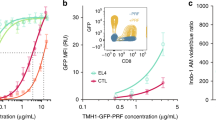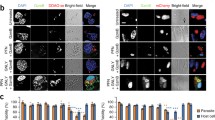Abstract
Natural killer (NK) cells and cytotoxic T lymphocytes (CTLs) kill target cells by the granule-exocytosis pathway and by the engagement of molecules belonging to the tumor necrosis factor family. The involvement of secretory phospholipase A2 (sPLA2) in the cytotoxic process has been proposed in NK cells. However, its molecular identity and intracellular localization remain unknown, and its mechanism of action is poorly understood. Here, we have readdressed this issue by studying the cytotoxic activity of whole cell extracts of a CTL line. We observed that inactivation of the perforin-granzyme pathway at 37°C in the presence of 1 mM Ca2+ enhanced the ability of CTL extracts to induce apoptosis. This potentiation of cell death was Ca2+-dependent, thermo-resistant, and inhibited by 4-bromophenacyl bromide and scalaradial (two inhibitors of sPLA2). The involvement of an sPLA2 was confirmed by blocking the pro-apoptotic activity of the Ca2+-treated cell extract with an anti-sPLA2 polyclonal antibody. By cell fractionation assays, we showed that the pro-apoptotic sPLA2 was localized in the cytoplasmic fraction but not in perforin-rich granules or plasma membrane fractions. Western blotting analysis revealed the presence of four distinct bands of 56, 29.5, 21, and 15 kDa. The highest molecular weight band was consistent with the expression of a group III sPLA2. Taken together, these data indicate that an apoptosis-inducing sPLA2 is expressed in the cytosol of a CTL cell line and suggest that it plays an effector role in CTL-mediated cytotoxicity.







Similar content being viewed by others
References
Ahmed KR, Guo TB, Gaal KK (1997) Islet rejection in perforin-deficient mice: the role of perforin and Fas. Transplantation 63:951–957
Barry M, Bleackley RC (2002) Cytotoxic T lymphocytes: all roads lead to death. Nat Rev Immunol 2:401–409
Bradford MM (1976) A rapid and sensitive method for the quantitation of microgram quantities of protein utilizing the principle of protein-dye binding. Anal Biochem 72:248–254
Capper EA, Marshall LA (2001) Mammalian phospholipases A(2): mediators of inflammation, proliferation and apoptosis. Prog Lipid Res 40:167–197
Carine K, Hudig D (1984) Assessment of a role for phospholipase A2 and arachidonic acid metabolism in human lymphocyte natural cytotoxicity. Cell Immunol 87:270–283
Cifone MG, Botti D, Festuccia C, Napolitano T, Grosso E del, Cavallo G, Chessa MA, Santoni A (1993) Involvement of phospholipase A2 activation and arachidonic acid metabolism in the cytotoxic functions of rat NK cells. Cell Immunol 148:247–258
Cifone MG, Roncaioli P, Cironi L, Festuccia C, Meccia A, D’Alo S, Botti D, Santoni A (1997) NKR-P1A stimulation of arachidonate-generating enzymes in rat NK cells is associated with granule release and cytotoxic activity. J Immunol 159:309–317
Coutinho-Silva R, Persechini PM (1997) P2Z purinoceptor-associated pores induced by extracellular ATP in macrophages and J774 cells. Am J Physiol 273:C1793–C1800
Cummings BS, McHowat J, Schnellmann RG (2000) Phospholipase A(2)s in cell injury and death. J Pharmacol Exp Ther 294:793–799
DeCoster MA (2003) Group III secreted phospholipase A2 causes apoptosis in rat primary cortical neuronal cultures. Brain Res 988:20–28
Deem RL, Britvan LJ, Targan SR (1987) Definition of a secondary target cell trigger during natural killer cell cytotoxicity: possible role of phospholipase A2. Cell Immunol 110:253–264
Diaz BL, Arm JP (2003) Phospholipase A(2). Prostaglandins Leukot Essent Fatty Acids 69:87–97
Frye LD, Friou GJ (1975) Inhibition of mammalian cytotoxic cells by phosphatidylcholine and its analogue. Nature 258:333–335
Fuly AL, Machado OL, Alves EW, Carlini CR (1997) Mechanism of inhibitory action on platelet activation of a phospholipase A2 isolated from Lachesis muta (Bushmaster) snake venom. Thromb Haemost 78:1372–1380
Gelb MH, Min JH, Jain MK (2000) Do membrane-bound enzymes access their substrates from the membrane or aqueous phase: interfacial versus non-interfacial enzymes. Biochim Biophys Acta 1488:20–27
Gorak-Stolinska P, Truman JP, Kemeny DM, Noble A (2001) Activation-induced cell death of human T-cell subsets is mediated by Fas and granzyme B but is independent of TNF-alpha. J Leukoc Biol 70:756–766
Gunji Y, Vujanovic NL, Hiserodt JC, Herberman RB, Gorelik E (1989) Generation and characterization of purified adherent lymphokine-activated killer cells in mice. J Immunol 142:1748–1754
Hanashiro MA, da Silva MH, Bier OG (1978) Neutralization of crotoxin and crude venom by rabbit antiserum to crotalus phospholipase A. Immunochemistry 15:745–750
Hoffman T, Hirata F, Bougnoux P, Fraser BA, Goldfarb RH, Herberman RB, Axelrod J (1981) Phospholipid methylation and phospholipase A2 activation in cytotoxicity by human natural killer cells. Proc Natl Acad Sci USA 78:3839–3843
Horwitz J, Perlman RL (1987) Measurement of inositol phospholipid metabolism in PC12 pheochromocytoma cells. Methods Enzymol 141:169–175
Koller M, Wachtler P, David A, Muhr G, Konig W (1997) Arachidonic acid induces DNA-fragmentation in human polymorphonuclear neutrophil granulocytes. Inflammation 21:463–474
Krähenbühl O, Rey C, Jenne D, Lanzavecchia A, Groscurth P, Carrel S, Tschopp J (1988) Characterization of granzymes A and B isolated from granules of cloned human cytotoxic T lymphocytes. J Immunol 141:3471–3477
Lambeau G, Lazdunski M (1999) Receptors for a growing family of secreted phospholipases A2. Trends Pharmacol Sci 20:162–170
Lee SH, Bar-Haim E, Machlenkin A, Goldberger O, Volovitz I, Vadai E, Tzehoval E, Eisenbach L (2004) In vivo rejection of tumor cells dependent on CD8 cells that kill independently of perforin and FasL. Cancer Gene Ther 11:237–248
Masamune A, Sakai Y, Satoh A, Fujita M, Yoshida M, Shimosegawa T (2001) Lysophosphatidylcholine induces apoptosis in AR42J cells. Pancreas 22:75–83
Milella M, Gismondi A, Roncaioli P, Bisogno L, Palmieri G, Frati L, Cifone MG, Santoni A (1997) CD16 cross-linking induces both secretory and extracellular signal-regulated kinase (ERK)-dependent cytosolic phospholipase A2 (PLA2) activity in human natural killer cells: involvement of ERK, but not PLA2, in CD16-triggered granule exocytosis. J Immunol 158:3148–3154
Milella M, Gismondi A, Roncaioli P, Palmieri G, Morrone S, Piccoli M, Frati L, Cifone MG, Santoni A (1999) Beta 1 integrin cross-linking inhibits CD16-induced phospholipase D and secretory phospholipase A2 activity and granule exocytosis in human NK cells: role of phospholipase D in CD16-triggered degranulation. J Immunol 162:2064–2072
Modolell M, Munder PG (1994) Macrophage mediated tumor cell destruction measured by an alkaline phosphatase assay. J Immunol Methods 174:203–208
Murakami M, Kudo I (2004) Secretory phospholipase A2. Biol Pharm Bull 27:1158–1164
Namiuchi S, Kumagai S, Imura H, Suginoshita T, Hattori T, Hirata F (1984) Quinacrine inhibits the primary but not secondary proliferative response of human cytotoxic T cells to allogeneic non-T cell antigens. J Immunol 132:1456–1461
Odake S, Kam C-M, Narasimhan L, Poe M, Blake JT, Krahenbuhl O, Tschopp J, Powers JC (1991) Human and murine cytotoxic T lymphocyte serine protease: subsite mapping with peptide thioester substrates and inhibition of enzyme activity and cytolysis by isocoumarins. Biochemistry 30:2217–2227
Ojcius DM, Zheng L-M, Sphicas EC, Zychlinsky A, Young JDE (1991) Subcellular localization of perforin and serine esterase in lymphokine-activated killer cells and cytotoxic T cells by immunogold labeling. J Immunol 146:4427–4432
Palladino MA, Obata Y, Stockert ER, Oettgen HF (1983) Characterization of interleukin 2-depenndent cytotoxic T-cell clones: specificity, cell surface phenotype, and susceptibility to blocking by Lyt antisera. Cancer Res 43:572–576
Pfeffer K, Matsuyama T, Kundig TM, Wakeham A, Kishihara K, Shahinian A, Wiegmann K, Ohashi PS, Mak TW (1993) Mice deficient for the 55 kd tumor necrosis factor receptor are resistant to endotoxic shock, yet succumb to L. monocytogenes infection. Cell 73:457–467
Podack ER, Young JDE, Cohn ZA (1985) Isolation and biochemical and functional characterization of perforin 1 from cytolytic T-cell granules. Proc Natl Acad Sci USA 82:8629–8633
Rizzardi GP, Brown L, Souberbielle BE, Dalgleish AG (1996) An alternative to Cr-51 release assay for measurement of natural killer activity in HIV-infected patients. AIDS 10:676–678
Shan D, Ledbetter JA, Press OW (1998) Apoptosis of malignant human B cells by ligation of CD20 with monoclonal antibodies. Blood 91:1644–1652
Shinzawa K, Tsujimoto Y (2003) PLA2 activity is required for nuclear shrinkage in caspase-independent cell death. J Cell Biol 163:1219–1230
Six DA, Dennis EA (2000) The expanding superfamily of phospholipase A(2) enzymes: classification and characterization. Biochim Biophys Acta 1488:1–19
Taketo MM, Sonoshita M (2002) Phospolipase A2 and apoptosis. Biochim Biophys Acta 1585:72–76
Thommesen L, Sjursen W, Gasvik K, Hanssen W, Brekke OL, Skattebol L, Holmeide AK, Espevik T, Johansen B, Laegreid A (1998) Selective inhibitors of cytosolic or secretory phospholipase A2 block TNF-induced activation of transcription factor nuclear factor-kappa B and expression of ICAM-1. J Immunol 161:3421–3430
Valentin E, Ghomashchi F, Gelb MH, Lazdunski M, Lambeau G (2000) Novel human secreted phospholipase A(2) with homology to the group III bee venom enzyme. J Biol Chem 275:7492–7496
Whalen MM, Doshi RN, Bader BW, Bankhurst AD (1999) Lysophosphatidylcholine and arachidonic acid are required in the cytotoxic response of human natural killer cells to tumor target cells. Cell Physiol Biochem 9:297–309
Young JDE, Hengartner H, Podack ER, Cohn ZA (1986) Purification and characterization of a cytolytic pore-forming protein from granules of cloned lymphocytes with natural killer activity. Cell 44:849–859
Acknowledgements
The authors wish to thank Drs. Russolina Zingale, Paulo Melo, Bruno L. Diaz, Bartira R. Bergmann, and Leda Q. Vieira for donating reagents, animals, and inhibitors, and Drs. João Viola, George dos Reis, Rodrigo C. Bisaggio, Robson Coutinho-Silva, André Fuly, Vera Koatz, Luciana Nogaroli, Cristiane M. Cruz, Miriam Werneck, and Camila Chaves Santos for helpful discussions.
Author information
Authors and Affiliations
Corresponding author
Additional information
This work was supported by the Conselho Nacional de Desenvolvimento Científico e Tecnológico (CNPq), Fundação Carlos Chagas Filho de Amparo à Pesquisa do Estado do Rio de Janeiro (FAPERJ), and Programa de Núcleos de Excelência (PRONEX–CNPq).
Rights and permissions
About this article
Cite this article
Costa-Junior, H.M., Hamaty, F.C., da Silva Farias, R. et al. Apoptosis-inducing factor of a cytotoxic T cell line: involvement of a secretory phospholipase A2 . Cell Tissue Res 324, 255–266 (2006). https://doi.org/10.1007/s00441-005-0095-y
Received:
Accepted:
Published:
Issue Date:
DOI: https://doi.org/10.1007/s00441-005-0095-y




